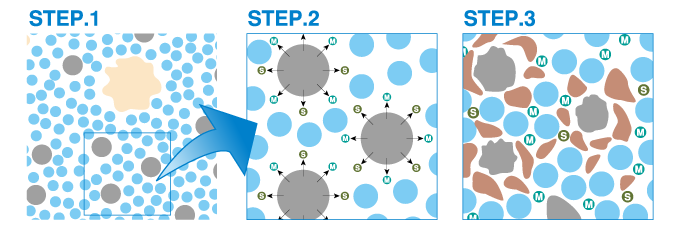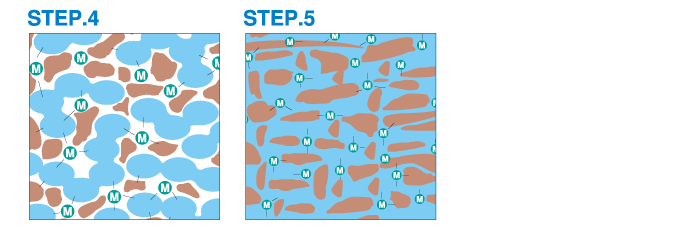Equipped with its unique self-closing function
The flexibility and unique water proof mechanism of PARATEX supplies quick protection against unexpected cracks in the construction material.
One unique feature Paratex waterproof materials is quick self-closing protection against unexpected cracks in waterproof layers. Constructions,
such as concrete water tanks, become vulnerable to temperature changes, humidity, and pressure after having been exposed to these factors for a long period of time. Paratex waterproof layers synchronise
with the movement of the concrete framework and prevent water-leaking problems with its self-closing protection when cracks have unexpectedly occurred in the construction material.
Waterproof Layers That Automatically Close Unexpected Cracks
| Cracks in a Concrete Foundation of a Building |
Crack-Vulnerable Condition |
Crack-Closed Condition |
- Paratex contains a high proportion of flexible resins, so it excels in crack-searching as well as in waterproofing.
|
- Because waterproof layers strongly adhere to the concrete framework, the layers can break as the framework breaks under the condition of zero-span tension.
|
- Waterproof layers inflate as they absorb inflowing water, and this process enhances chemical interactions inside the layers, resulting in synthesized chemical compounds that help close cracks in the construction material.
|
Self-Closing Mechanism of Paratex Waterproofing
| By mixing Paratex emulsion with Paratex admixture, the dispersions of EVA resin, alumina ceramics, and aggregate become uniform in the emulsion liquid. |
Metal ions and hydrated components in alumina ceramics flow into the emulsion liquid. |
The hydrated components consume water of the emulsion liquid, and subsequently the components turn into inorganic hydrates. |
| During the hydration process, the inorganic hydrates, metal ions, and EVA resin start the crosslinking reaction. During this process, an EVA merges simultaneously with another EVA. |
The processes of the water dispersion, crosslinking reaction, and fusion of the resins eventually result in serial films which function as solid, flexible waterproof layers. |
|


